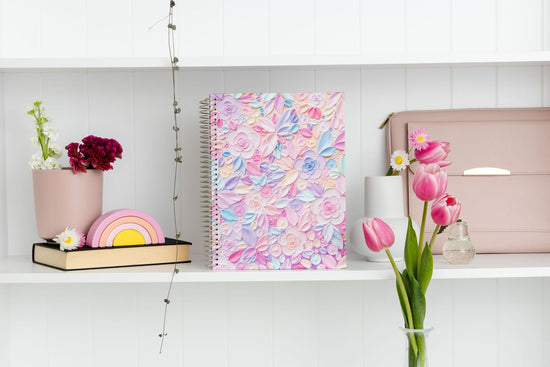Setting Up Your Teacher Planner for a Week of Smooth Teaching
Hey teacher!
Welcome to another installment of our teacher-focused blog, where we dive into the details of making your week more organised and stress-free.
Today, we're chatting about the magic that happens when you plan your week like a pro.
Get ready, because we'll be sharing some simple yet powerful tips on setting up your teacher planner, ensuring a week of seamless teaching and maximum productivity.
So, grab your favourite planner, a cup of tea, and let's embark on this journey to make your teaching week a breeze!
Choose Your Planning Day
Let's kick things off with the first crucial step: pick a designated day and time to plan for the upcoming week.
Friday is our golden ticket here. Why, you ask?
Well, planning on Friday allows you to enter the weekend with a clear head. Imagine the bliss of enjoying your Saturday and Sunday without the looming cloud of lesson plans and to-dos. It's like a mini holiday for your mind before the next week begins.
The main thing is to pick a consistent time or day each week to sit down with your teacher planner and plan for the week ahead.
Add Key Dates To Your Teacher Planner
Once you've secured your planning day, it's time to dive into the nitty-gritty.
Start by adding all upcoming events to teacher planner. This includes specialist lessons, school assemblies, essential dates, and those staff meetings that seem to pop up out of nowhere.
Knowing what's on the horizon helps you mentally prepare and ensures you won't be caught off guard.
We love using the monthly calendar to mark out any events that the school is holding. Mark them in your teacher planner as soon as your receive the email letting you know the event and date
Hot Tip: For repetitive tasks like staff meetings or lunch duty - we love to use planner stickers save us the time of writing them out again and again.
Map Out Your Tasks For The Week
Now, let's get down to business. Map out the week's tasks with precision – from crafting that engaging parent newsletter to firing off those crucial emails and planning specific lessons.
Take a closer look at deadlines. If these tasks are tied to specific dates, make a point to jot them into your teacher planner for the respective day or even a day prior.
This foresight not only ensures you're well-aware of impending responsibilities but also empowers you to prioritise tasks effectively, managing your time with finesse.
Consider your planner as your compass, guiding you through the week's journey. By strategically allocating tasks to specific days, you create a roadmap for success.
This method of organisation not only prevents the overwhelming feeling of looming deadlines but also allows you to allocate your time and energy efficiently.
Remember, a well-planned week sets the stage for smoother sailing.
Who doesn't want to navigate the week with a sense of control and ease?

Create Your To Do List
Alright, let's talk logistics.
You've got your tasks lined up, and now it's time to transition from the big picture to the finer details.
Break down your overarching goals into bite-sized, actionable steps that pave the way for a smoother week ahead.
Create a to-do list that outlines the specific materials you'll need. Consider everything from worksheets to be copied, books to borrow from the library, and any other essential resources required for your upcoming lessons.
This proactive approach ensures that you're not caught scrambling at the last minute, fostering a stress-free environment for both you and your students.
By taking the time to plan and gather materials in advance, you're setting yourself up for success, allowing you to focus on delivering engaging and impactful lessons rather than dealing with last-minute logistics.
Create Your To Do List
Our planning time is a valuable window not just for organising our teaching materials but also for ensuring the accuracy and completeness of our student records.
A big shoutout to Mrs. Edgar Planners for providing us with the ideal tool – their planners boast 10 spreads of assessment recording space, making it the perfect hub to meticulously keep track of student information.
So, seize this moment to not only map out your lessons but also to dedicate a little extra time to update those records.
By doing so, you're not just creating an efficient teaching plan but also fostering an environment of detailed student understanding and progress monitoring.
Be Realistic With Your Planning
Being realistic with our planning involves recognising that the landscape of our work is dynamic, and things can change at the drop of a hat.
It's about understanding that despite our best efforts to plan meticulously, unforeseen circumstances may arise. Flexibility becomes our ally in navigating the ever-shifting terrain of teaching.
By acknowledging that change is inevitable, we empower ourselves to adapt seamlessly when needed. Realism in planning is not about anticipating every twist and turn; it's about building a resilient mindset that embraces adaptability.
So, as we chart our course for the week, let's keep in mind that our plans are a roadmap, not a rigid set of instructions. With an open mindset, we can approach each day with the agility needed to handle whatever comes our way.
We genuinely hope that our journey together through this blog has injected a burst of motivation into your planning game.
The aim? To leave you feeling pumped up and ready to tackle the upcoming week with newfound organisation. Because, let's face it, when we're organised, we're unstoppable!
So, here's to feeling motivated, staying organised, and embracing the week ahead with confidence. You've got this!
PS: Want more fun tips and free resources for your classroom? Subscribe to our email list for a treasure trove of exciting ideas delivered straight to your inbox! Click here to subscribe


























Leave a comment